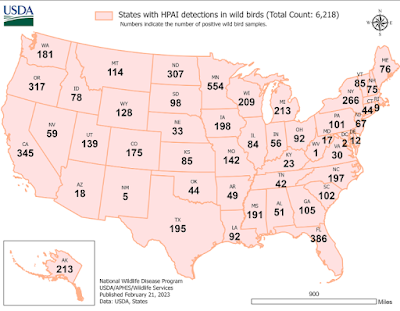#17,320
With the dual caveats that many birds and mammals die in remote and difficult to access places, and are never discovered or tested - and some states appear to be more proactive in investigating outbreaks than others - we have the latest update from the USDA on wild bird die offs from H5N1, and spillover into mammalian wildlife.
Since their last update 3 weeks ago, the USDA has added 10 additional mammalian infections with H5N1, with the bulk of those (n=7) coming from Colorado (note: only 9 shown in the list below). Species include bobcat (n=2), red fox (n=2 ), mountain lion (n=3 ), skunk (n=1) and American Black bear (n=2).
With the lone exception of a single infected Bottlenose Dolphin in Florida, all of the reports of mammalian infection have come from the northern tier of states.
Peridomestic mammals, like red foxes and skunks, remain the most commonly reported terrestrial mammals infected, although we are seeing an increasing number of big cats and bears being infected in recent months.While this may be due to more mammalian adapted strains circulating in those regions (see Preprint: Rapid Evolution of A(H5N1) Influenza Viruses After Intercontinental Spread to North America), it may also come down to differences in climate and terrain (swamps vs. forests vs. deserts), and the fact that some states may be looking harder than others.
While the full extent of H5N1's impact on wildlife is unknown, we are likely seeing only the tip of the iceberg.


